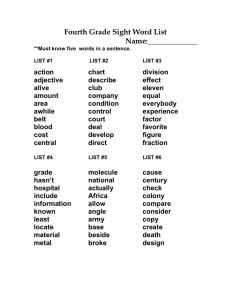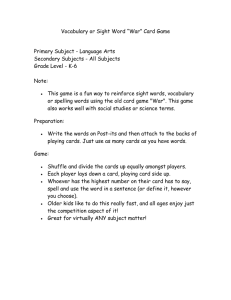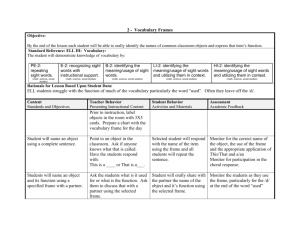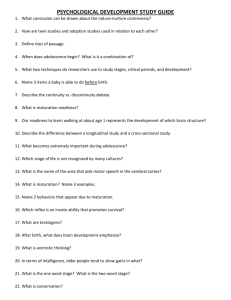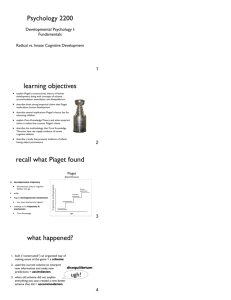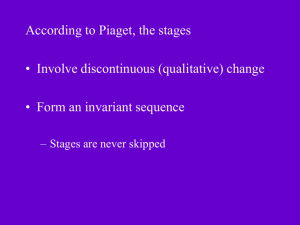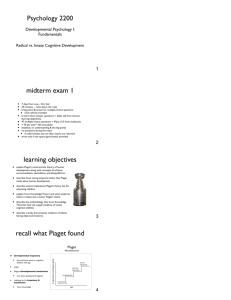Infant Perception
advertisement
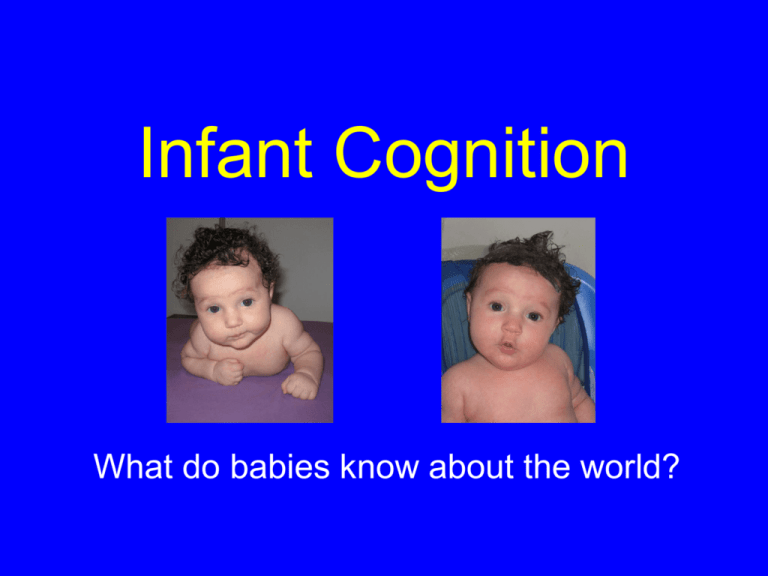
Infant Cognition What do babies know about the world? Piaget’s Theory Jean Piaget (1896-1980) Swiss psychologist Father of modern cognitive developmental psychology Infant Cognition: Piaget’s Claims • Out of sight, out of mind – No concept of object permanence • Senses are uncoordinated – No intermodal perception Object Permanence • Objects continue to exist when they are out of sight Piagetian Search Tasks Show infants a toy, and as they reach for it, hide the toy under a cloth 0 - 8 months: 8 - 12 months: 12 - 18 months: 18 - 24 months: No search A-not-B error Invisible displacement Object permanence A-not-B Error Video Clip Malena May 19, 2006 age: 9 months, 27 days Why do babies make the A-not-B error? • Poor memory – Task is easier if locations are very distinct • Can’t resist the first location – Reach to A even when object is visible at B – Babies look to B first, but reach to A Tests of Object Permanence: Eliminating the need for a motor response • Present infants with an event that violates object permanence • Are babies surprised by such an event? Baillargeon’s Test of Object Permanence 3.5-month-olds Baillargeon, 1987 Baillargeon Video Clip “It’s a Kid’s World” hosted by Alan Alda Amazing Infant Cognition • Object Permanence – Baillargeon: rotating screen; two “Minnies” • Support / Gravity – Baillargeon: box on platform • Physical Causality – Spelke: object contact makes things move Physical Causality The Role of Contact 6-month-olds Habituation Event: Physical Causality The Role of Contact Test Events: Impossible Possible Physical Causality The Role of Contact If infants understand contact as a mechanism for cause and effect, they should look longer at (dishabituate to) the impossible ________________ event. Results: 6-month-olds look longer at impossible event. Intermodal Perception • Integrating information from two or more senses when perceiving an object or event – e.g., the coordination of sight and sound Intermodal Perception Integrating Sight and Sound (Spelke, 1976) Drumbeats Video A Speaker Peek-a-boo Video B Playing drum Baby Where does baby look? Intermodal Perception Sight and Sound: Findings • 4-month-olds can integrate sight and sound • Wide range of phenomena – Emotion (facial expressions with voice) – Gender (male voice with male face) – Speech sounds (vowel sounds with mouth movements) – Speech synchrony (soundtrack with mouth movements) – Number (items in a display with number of drumbeats) Intermodal Perception Integrating Sight and Touch (Meltzoff & Borton, 1979) Infants suck bumpy or smooth pacifier for 90 seconds (without seeing it). Then they see pictures of two spheres: bumpy & smooth 1-month-olds can integrate sight and touch (newborns can do it: Kaye & Bower, 1994) Intermodal Perception Integrating Sight and Proprioception (Meltzoff & Moore, 1977, 1989, 1994) Imitation at birth: Newborns can make their own facial expressions match those of another person. Summary • Knowledge about the physical world appears early and develops rapidly • Infant perception and cognition are coordinated and active Piaget’s Stages • Sensorimotor (birth - 2 years) • Preoperational (2 - 7 years) • Concrete Operational (7 - 11 years) • Formal Operational (11 years - adult) Limitations of Preoperational Thought • Centration • Egocentrism • Appearance as reality • Transductive reasoning Centration • Focusing on one aspect of a problem, ignoring other relevant aspects • Examples – Conservation – Class inclusion Conservation of Number Conservation of Liquid Class Inclusion Are there more apples or more fruit? Egocentrism • Thinking everyone sees things the same way you do • Difficulty taking another’s perspective • Examples – Three-mountains task – Egocentric speech Three Mountains Task Child is asked to pick the picture that shows what the diorama looks like from the partner’s point of view. Egocentric Speech • Child and partner - separated by a barrier - have identical sets of cards • Child has to describe one card to the partner “It’s the dinosaur!” “The one with a tail.” Appearance as Reality • Tendency to confuse what something looks like with what it really is • Example – Fear of Halloween costumes Appearance as Reality Transductive Reasoning • Reasoning from one particular to another • Indifference to cause-and-effect relations • Example – Unconventional connections “I haven’t had a nap, so it isn’t afternoon.” Strengths of Preoperational Thought • Symbolic representation • Pretend play

